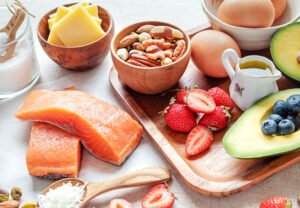
Weight Loss Diet Programs

Are you looking to lose weight but not sure where to start? With numerous weight loss programs available today, choosing the right one can be overwhelming.
Table of Contents
Introduction
In this comprehensive guide, we will delve into some of the most popular weight loss programs and help you determine which program might be the best fit for your needs and goals.

Weight Loss Diet Programs
The Atkins Diet

The Atkins Diet is a low-carbohydrate, high-fat diet that was introduced by Dr. Robert C. Atkins in the 1960s. This diet aims to shift the body’s metabolism from using carbohydrates as the primary source of energy to burning stored fat for fuel. The Atkins Diet is divided into four phases: the induction phase, ongoing weight loss phase, pre-maintenance phase, and maintenance phase.
During the induction phase, which typically lasts for two weeks, carbohydrate intake is severely limited to around 20-25 grams per day. During this phase, individuals are encouraged to consume high-fat, high-protein foods such as meat, fish, eggs, and cheese. This restriction on carbohydrates puts the body into a state of ketosis, where it starts breaking down fats for energy.
In the ongoing weight loss phase, carbohydrates are gradually added back into the diet in the form of nutrient-dense vegetables, nuts, and berries. The goal is to find the individual’s “critical carbohydrate level for losing weight” – the maximum amount of carbohydrates they can consume while still losing weight. This phase continues until the individual is about 10 pounds away from their target weight.
The pre-maintenance phase focuses on fine-tuning the diet and gradually increasing carbohydrate intake. This phase prepares individuals for the long-term maintenance phase, where they aim to maintain their weight loss by following a controlled carbohydrate intake that suits their body’s needs.
The Atkins Diet has been popular for its potential to promote rapid weight loss, especially during the induction phase. The low carbohydrate intake leads to a decrease in insulin levels, which can facilitate fat burning. However, critics have raised concerns about the long-term sustainability and potential health risks associated with a high-fat diet, such as increased cholesterol levels and cardiovascular problems. It is essential to consult with a healthcare professional before starting the Atkins Diet, especially if you have any pre-existing health conditions.
The Mediterranean Diet

The Mediterranean Diet is inspired by the traditional eating habits of countries bordering the Mediterranean Sea, such as Greece, Italy, and Spain. It emphasizes whole foods, primarily plant-based, with a focus on fruits, vegetables, whole grains, legumes, nuts, and healthy fats.
This diet encourages the consumption of fruits and vegetables, which are rich in vitamins, minerals, and fiber. It also emphasizes whole grains like brown rice, quinoa, and whole wheat bread, providing complex carbohydrates and additional fiber. Legumes such as beans, lentils, and chickpeas are excellent sources of plant-based protein and fiber.
The Mediterranean Diet encourages the use of healthy fats, particularly olive oil, which is a staple in Mediterranean cuisine. Olive oil contains monounsaturated fats, which can have a positive impact on heart health. It also includes moderate consumption of fish, which provides omega-3 fatty acids known for their cardiovascular benefits.
Red meat consumption is limited in the Mediterranean Diet, with an emphasis on lean sources of protein like poultry and fish. Dairy products are consumed in moderation, with options like yogurt and cheese often included.
One of the significant advantages of the Mediterranean Diet is its flexibility and variety. It doesn’t impose strict calorie counting or the complete elimination of food groups. This makes it easier for individuals to adhere to the diet long-term and incorporate it into their lifestyle.
Research has shown that the Mediterranean Diet is associated with numerous health benefits. It has been linked to a reduced risk of heart disease, stroke, type 2 diabetes, and certain types of cancer. Additionally, it has been shown to promote weight loss and weight management when combined with regular physical activity.
The DASH Diet

The DASH (Dietary Approaches to Stop Hypertension) Diet was initially developed to lower blood pressure, but it has gained popularity as a weight loss program. It emphasizes whole foods, particularly fruits, vegetables, whole grains, lean proteins, and low-fat dairy products.
The DASH Diet is rich in fruits and vegetables, which are excellent sources of vitamins, minerals, and fiber. These foods contribute to overall health and weight management. Whole grains like brown rice, whole wheat bread, and oatmeal provide complex carbohydrates and fiber, promoting satiety and stabilizing blood sugar levels.
Lean proteins, such as poultry, fish, and legumes, are encouraged on the DASH Diet. These protein sources are lower in saturated fat compared to red meat, which can have a positive impact on heart health.
Low-fat dairy products are included in moderate amounts, providing calcium, protein, and other essential nutrients. However, individuals with lactose intolerance or dairy allergies can opt for non-dairy alternatives like almond milk or soy milk.
The DASH Diet emphasizes foods that are high in fiber and low in saturated fat and sodium. By reducing sodium intake, this diet promotes healthy blood pressure levels and cardiovascular health.
One of the advantages of the DASH Diet is its flexibility. It can be customized to meet individual preferences and dietary restrictions. For example, vegetarians can adapt the diet by focusing on plant-based proteins instead of animal-based proteins.
Studies have shown that the DASH Diet can lead to weight loss, improved heart health, and better blood pressure control. Its emphasis on whole foods and balanced nutrition makes it a sensible choice for long-term weight management and overall well-being.
The Whole30 Program

The Whole30 Program is a 30-day program designed to reset your eating habits and identify foods that may be causing inflammation or digestive issues in your body. It involves eliminating certain foods from your diet, including sugar, alcohol, grains, legumes, dairy, and processed foods.
The Whole30 Program aims to promote a healthier relationship with food and improve overall well-being. It encourages the consumption of whole, unprocessed foods such as fruits, vegetables, lean proteins, nuts, and seeds. During the program, individuals are advised to focus on high-quality sources of nutrients and avoid added sugars, artificial sweeteners, and preservatives.
By eliminating potentially problematic foods for 30 days, the program allows individuals to identify any food sensitivities or allergies they may have. After the 30 days, foods are gradually reintroduced one at a time to observe any adverse reactions.
While the Whole30 Program can lead to weight loss in the short-term due to the elimination of processed foods and added sugars, its strict restrictions and elimination of entire food groups can be challenging to maintain long-term. It requires careful meal planning and preparation, as many convenience foods and restaurant options are not compliant with the program’s guidelines.
The Whole30 Program is often seen as a reset or jump-start to healthier eating habits. It can help individuals become more aware of the impact of certain foods on their well-being and make more informed choices in the long run. However, it is important to note that the program’s 30-day duration is not intended to be a sustainable long-term eating plan.
The Paleo Diet

The Paleo Diet, also known as the Paleolithic Diet or the Caveman Diet, is based on the idea of eating foods similar to those consumed by our ancestors during the Paleolithic era. The diet emphasizes whole, unprocessed foods while excluding grains, legumes, dairy products, and processed foods.
The foundation of the Paleo Diet consists of lean meats, fish, fruits, vegetables, nuts, and seeds. These foods are nutrient-dense and provide a variety of vitamins, minerals, and antioxidants. The diet encourages the consumption of high-quality proteins and healthy fats, such as those found in grass-fed meats, wild-caught fish, avocados, and olive oil.
The exclusion of grains and legumes in the Paleo Diet is based on the belief that these foods were not part of our ancestors’ diet. Proponents of the diet argue that grains and legumes contain anti-nutrients and may contribute to inflammation and digestive issues in some individuals.
Critics of the Paleo Diet express concerns about its long-term sustainability and potential nutrient deficiencies. The elimination of entire food groups, such as grains and dairy, may result in inadequate intake of certain vitamins and minerals, such as calcium and vitamin D. Careful planning and consideration of alternative food sources are necessary to ensure a well-rounded nutrient intake.
While the Paleo Diet can lead to weight loss and improved health markers, it may not be suitable for everyone. It is important to consult with a healthcare professional or registered dietitian before starting the diet, especially if you have any pre-existing health conditions or specific dietary needs.
Overall, the Paleo Diet promotes the consumption of whole, unprocessed foods and limits the intake of refined sugars and processed foods, which can be beneficial for weight management and overall health. However, it is important to ensure that nutritional needs are met through careful food selection and, if necessary, appropriate supplementation.
The Vegan Diet

The Vegan Diet is a plant-based diet that excludes all animal products, including meat, fish, dairy, eggs, and honey. It focuses on consuming a wide variety of fruits, vegetables, whole grains, legumes, nuts, and seeds.
The Vegan Diet is rich in fiber, vitamins, minerals, and antioxidants found in plant-based foods. It can contribute to weight loss and improved heart health due to its low saturated fat content and high fiber intake. Additionally, a well-planned vegan diet can provide all the necessary nutrients, including protein, iron, calcium, and omega-3 fatty acids.
However, adopting a vegan lifestyle requires careful planning to ensure adequate intake of essential nutrients that are primarily found in animal products. For example, vegans may need to pay attention to sources of vitamin B12, which is naturally present in animal foods. It may be necessary to include fortified foods or consider supplementation to meet nutrient requirements.
The Vegan Diet can be challenging for some individuals, especially those who are accustomed to consuming animal products. It may require learning new cooking techniques, exploring plant-based alternatives, and finding suitable sources of protein and other essential nutrients.
While the Vegan Diet offers health benefits, it is important to approach it with a balanced and varied food selection to ensure nutritional needs are met. Consulting with a registered dietitian or healthcare professional can provide guidance and support when transitioning to a vegan lifestyle.
Each diet mentioned above has its own principles, benefits, and considerations. It is important to choose a diet that aligns with your individual goals, preferences, and overall health status.
Consulting with a healthcare professional or registered dietitian can provide personalized advice and guidance to help you make informed decisions about your dietary choices.
Note: There might be affiliate links mentioned here. We may receive a commission if you purchase a product through an affiliate link. There is no additional charge for you. Please do your own research before making any online purchases.
The Low-Fat Diet

The Low-Fat Diet is a dietary approach that involves reducing overall fat intake, typically to less than 30% of daily calories. It gained popularity in the 1990s as a means to promote weight loss and improve heart health.
The Low-Fat Diet emphasizes the consumption of fruits, vegetables, whole grains, and lean proteins while limiting high-fat foods like butter, oil, and fatty meats. The diet encourages the inclusion of foods that are low in saturated and trans fats, as these fats have been associated with an increased risk of heart disease.
By reducing fat intake, the Low-Fat Diet aims to lower overall calorie consumption. Fat is energy-dense, providing more than twice the calories per gram compared to carbohydrates or protein. Therefore, by reducing fat intake, individuals may be able to achieve a calorie deficit and promote weight loss.
The Low-Fat Diet has been associated with positive effects on heart health, as it can help lower LDL (bad) cholesterol levels. It is also often recommended for individuals with certain medical conditions, such as gallbladder disease or pancreatitis, where a low-fat diet can be beneficial.
However, some experts have raised concerns about the potential negative effects of the Low-Fat Diet on blood sugar control and overall nutrient intake. When fat is reduced, there is a tendency to compensate by increasing carbohydrate intake, which can affect blood sugar levels, particularly in individuals with diabetes or insulin resistance. It is important to choose healthy sources of carbohydrates, such as whole grains, fruits, and vegetables, while moderating portion sizes.
It is worth noting that not all fats are created equal. While saturated and trans fats should be limited, the Low-Fat Diet should still include sources of healthy fats, such as avocados, nuts, seeds, and olive oil. These fats provide essential fatty acids and fat-soluble vitamins that are important for overall health.
The effectiveness and sustainability of the Low-Fat Diet can vary among individuals. Some may find it challenging to adhere to a low-fat eating pattern long-term, especially if it requires significant changes in food choices and preparation methods. As with any diet, it is important to consider personal preferences and ensure that the chosen approach is compatible with your lifestyle and promotes overall well-being.
The Zone Diet

The Zone Diet is a low-carbohydrate, moderate protein, and low-fat diet that was popularized by Dr. Barry Sears in the 1990s. The diet’s main focus is on balancing macronutrient ratios to control insulin levels and promote weight loss.
The Zone Diet recommends consuming three meals and two snacks per day, with each meal consisting of 40% carbohydrates, 30% protein, and 30% fat. The idea behind this ratio is to maintain stable blood sugar levels and optimize hormone balance.
The diet encourages the consumption of lean proteins, such as poultry, fish, and tofu, along with carbohydrates from fruits, vegetables, and whole grains. Healthy fats, such as those found in nuts, seeds, and olive oil, are also incorporated into the diet.
By controlling the balance of macronutrients, the Zone Diet aims to regulate insulin levels, which can influence fat storage and metabolism. It advocates for portion control and moderation in food choices to maintain a balanced ratio of nutrients.
The Zone Diet has been praised for its potential to promote weight loss, reduce inflammation, and improve overall health markers. However, critics argue that its strict macronutrient ratios and emphasis on processed, pre-packaged foods may not be sustainable or optimal for long-term health.
Individuals considering the Zone Diet should be mindful of the quality of food choices within the recommended macronutrient ratios. It is important to focus on whole, unprocessed foods and prioritize nutrient density to ensure adequate intake of vitamins, minerals, and other essential nutrients.
As with any diet, the Zone Diet may not be suitable for everyone. It is important to consider individual preferences, lifestyle factors, and any underlying health conditions before adopting this approach. Consulting with a registered dietitian or healthcare professional can provide personalized guidance and support.
Low-Calorie Diet
A low-calorie diet is a weight loss approach that focuses on reducing overall calorie intake. The principle behind this diet is that by consuming fewer calories than your body needs for daily activities and metabolism; you create a calorie deficit that leads to weight loss. Typically, a low-calorie diet involves consuming around 1,200 to 1,500 calories per day.
One of the key benefits of a low-calorie diet is its simplicity. It doesn’t require eliminating specific food groups or following complicated meal plans. Instead, it emphasizes portion control and making healthier food choices. By reducing calorie intake, individuals can achieve steady and gradual weight loss over time.
However, there are some potential drawbacks to consider. Severely restricting calories can lead to feelings of hunger, fatigue, and a lack of essential nutrients if not carefully planned. It’s important to prioritize nutrient-dense foods to ensure adequate vitamin, mineral, and protein intake. Additionally, a low-calorie diet may not be suitable for everyone, especially individuals with certain medical conditions or those who require higher calorie intake due to their activity levels.
Low-Carb Diet

A low-carbohydrate (low-carb) diet is a weight loss approach that focuses on reducing the consumption of carbohydrates, such as grains, starchy vegetables, and sugary foods. The primary principle of a low-carb diet is to encourage the body to burn stored fat for energy instead of relying on carbohydrates. This is achieved by limiting carbohydrate intake to around 20-100 grams per day, depending on the specific diet plan.
Low-carb diets often emphasize the consumption of protein, healthy fats, and non-starchy vegetables. By reducing carbohydrate intake, insulin levels decrease, leading to a metabolic state known as ketosis. Ketosis is believed to promote fat burning and weight loss.
One of the advantages of a low-carb diet is its effectiveness in promoting rapid initial weight loss, which can provide motivation for individuals starting their weight loss journey. Additionally, low-carb diets have shown positive effects on blood sugar control and triglyceride levels in individuals with insulin resistance or diabetes.
However, it’s important to note that low-carb diets vary in their carbohydrate restriction levels, and extreme versions may eliminate healthy foods like fruits, legumes, and whole grains. There may also be concerns about the long-term sustainability of such diets and potential nutrient deficiencies if not properly balanced.
Intermittent Fasting

Intermittent fasting is an eating pattern that involves alternating periods of fasting and eating. There are several popular methods of intermittent fasting, including the 16/8 method (fasting for 16 hours and eating within an 8-hour window) and the 5:2 method (eating normally for five days and significantly reducing calorie intake to 500-600 calories on two non-consecutive days).
Intermittent fasting is based on the notion that by extending the time between meals, the body’s insulin levels decrease, allowing stored fat to be used for energy. It can also lead to a reduction in overall calorie intake since there are fewer hours available for eating.
One of the primary advantages of intermittent fasting is its flexibility. It doesn’t restrict specific food groups or require complicated meal plans. Additionally, some studies suggest that intermittent fasting may have beneficial effects on metabolism, insulin sensitivity, and cellular repair processes.
However, intermittent fasting may not be suitable for everyone. Individuals with a history of disordered eating, certain medical conditions, or those who are pregnant or breastfeeding should consult with their healthcare provider before attempting intermittent fasting. Additionally, adherence to the fasting periods and managing hunger during fasting hours can be challenging for some individuals.
Choosing the Right Weight Loss Program

With numerous weight loss programs available, choosing the right one can be a daunting task. It is essential to consider various factors to ensure the program is a good fit for your needs and preferences. Here are some key factors to consider:
- Personal preferences and lifestyle: Select a program that aligns with your personal preferences and fits seamlessly into your lifestyle. If you enjoy cooking and preparing your meals, a program that involves meal planning and food tracking may be a good fit. On the other hand, if you prefer a more flexible approach, a program that allows for a variety of foods and meal options may be better suited for you.
- Sustainability: Opt for a weight loss program that is sustainable in the long term. Avoid programs that involve extreme restrictions or the elimination of entire food groups, as they may be challenging to maintain over time. Look for an approach that promotes balanced eating and provides a framework for making healthy choices even after reaching your weight loss goals.
- Health considerations: Consider any pre-existing health conditions or medical concerns you may have when choosing a weight loss program. Certain diets or approaches may be contraindicated or require modification for individuals with specific health conditions. It is always recommended to consult with a healthcare provider before starting any new program to ensure it is safe and appropriate for you.
- Accountability and support: Look for a weight loss program that offers accountability and support. This can come in the form of in-person meetings, online communities, mobile apps, or working with a registered dietitian or weight loss coach. Having a support system can be beneficial for motivation, guidance, and staying on track with your goals.
Conclusion
Therefore, selecting the right weight loss program is crucial for achieving successful and sustainable weight loss. By considering personal preferences, sustainability, health considerations, and the availability of accountability and support, you can make an informed decision and choose a program that fits your lifestyle and promotes overall well-being. Remember, it is always recommended to consult with a healthcare professional or registered dietitian before embarking on any significant dietary changes or weight loss programs.
Disclaimer: The information provided in this article is for educational purposes only and should not be considered as a substitute for medical advice. Consult a healthcare professional before implementing any home remedies or making significant changes to your lifestyle.






